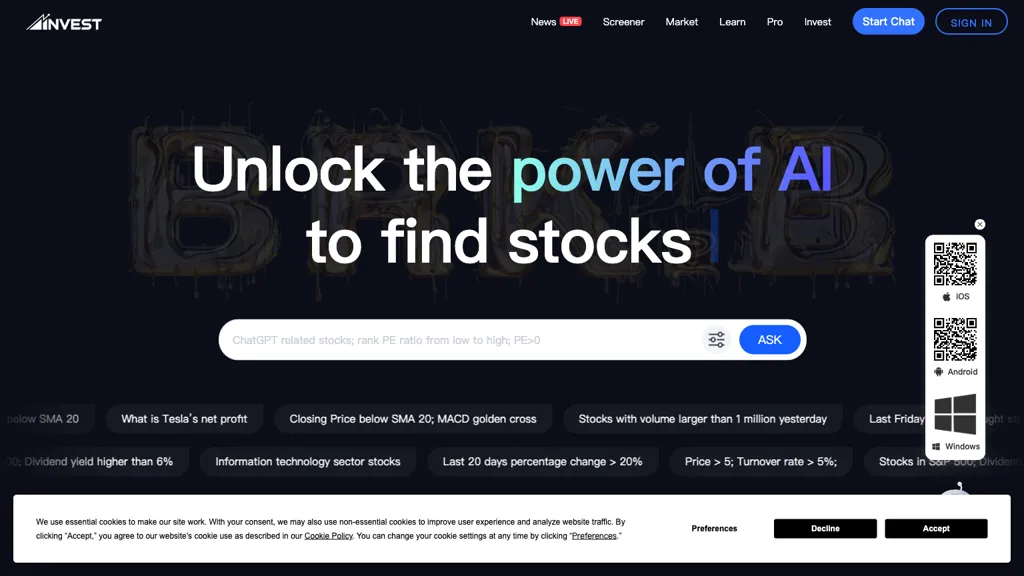AI stock-Predicting/Analyzing platforms offer various options for customization, which allow users to modify their platform to meet their individual trading goals as well as their risk tolerance and market condition. A platform with extensive customization options can greatly increase the effectiveness of trading. Here are 10 great suggestions to help you assess the capabilities of a platform to modify your strategy
1. Evaluate Pre-Built Strategy Templates
Variety of templates: Check whether the platform provides an array of pre-designed strategies that can be used for various trading styles (e.g. swing trading, day trading, long-term investing).
User-friendliness: Consider the ease with which you can apply and modify these templates to meet your needs.
Performance history: Confirm that the platform contains past performance data for pre-built strategic plans.
2. Create Custom Strategy
Drag-and-drop applications: Search for platforms that provide user-friendly drag and drop interfaces for customizing strategies.
Check the platform's coding options. Advanced users might want to utilize custom scripting language (e.g. Python or R).
Flexibility: Make sure the platform allows you to define entry/exit requirements as well as risk management parameters and other key components of your plan.
3. Check for Backtesting Capabilities
Data historical: Check whether there is enough facts to back-test your strategies.
Customizable parameter: Make sure you can adjust parameters while backtesting (e.g. indicators, timeframes).
Performance metrics: Verify whether the platform has detailed performance metrics for backtested strategies (e.g. win rate, sharpe ratio drawdown, etc.).
4. Evaluate Real-Time Strategy Testing
Paper trading Try out strategies in real-time using paper trading or simulation.
Live testing: See if you can run strategies in live markets with tiny amounts of capital to assess their performance.
Real-time adjustments - Check if you are able to modify your strategies in real time in response to market conditions.
5. Assess Integration with Technical Indicators
Indicator library: Check whether a platform offers an extensive library of technical indicators, such as moving averages (e.g. RSI), MACD, or RSI.
Custom indicators: Make sure that you have the ability to import or develop custom indicators to match your plans.
Combination of indicators Check to see if the platform supports combining multiple indicators for more complex strategies.
6. Check for Risk Management Tools
Stop-loss/take-profit: Ensure the platform allows you to set stop-loss and take-profit levels within your strategies.
Position sizing: Find out if you are able to establish rules for sizing positions (e.g. the amount that is fixed or percentage of the portfolio) to help manage risk.
Risk-reward rate: Determine if the platform allows for setting risk-reward rates specific to strategies or for individual trades.
7. Evaluate Multi-Asset Strategy Support
Asset Classes: Ensure that the platform supports strategies that are based on multiple asset types (e.g. ETFs, Options, Forex, Stocks).
Cross-asset Strategies: Examine whether it is feasible to develop strategies that combine different asset classes.
Market coverage: Check if the platform has coverage for those markets that you're interested in (e.g., US, international, cryptocurrencies).
8. Review the automation, Execution and Execution
Automated trading: Ensure that the platform can automate execution of strategies based on predetermined rules.
Types of orders: Examine to see if the system permits different types of orders (e.g. limit and market) in the course of executing a strategy.
Latency: Determine if the platform is able to execute trades quickly, particularly in high-frequency trading strategies.
9. Take a look at the Strategy Optimization Tools
Optimizing parameters: Make sure that the platform has tools to optimize the parameters of your strategy (e.g. grid search, genetic algorithms).
Integration of machine learning: Determine whether the platform is integrated with machine learning to refine and optimize strategies.
Analysis of scenarios: Check if the platform allows testing strategies for different market scenarios (e.g., bear, bull or volatile).
Review User Support for Community Reviews and Feedback
The feedback of users is crucial in determining the effectiveness of the platform.
Community forums: Find out whether the platform hosts an active community where users can discuss and share their custom strategies.
Support resources: Make sure that the platform has documentation, tutorials, and webinars that will help users create and implementing strategies.
Bonus Tips
Trial period: Try an unpaid trial or demo to test the platform's strategy customization features.
Scalability: Ensure the platform you choose to use can deal with complex strategies that evolve when you trade.
Support for customers: Find out if the platform offers support for any strategy-related queries.
The following tips can help you assess the ability of AI trading platforms to tailor their strategies. You'll be able decide which one best fits your needs in trading and allow you to improve and implement your plan. A platform that has flexible options for customization can allow users to be able to change market conditions and enhance the performance of your trading. Check out the best AI stock picker for website recommendations including stock ai, incite, trading with ai, options ai, market ai, AI stock, best ai for trading, market ai, AI stock, AI stock market and more.

Top 10 Tips To Evaluate The Potential And Flexibility Of AI stock Trading Platforms
To ensure the AI-driven stock trading and forecasting platforms meet your expectations It is important to evaluate their trial and flexible options before committing long-term. Here are the top 10 suggestions for evaluating each of these aspects:
1. Try it out for free
Tips - Find out whether the platform allows you to try out its features for no cost.
You can evaluate the platform for free.
2. The Trial Period and its Limitations
Tips: Check the duration of your trial as well as any limitations you may encounter (e.g. restricted features, limited access to data).
The reason: Once you understand the limitations of the trial it is possible to determine if it's a complete assessment.
3. No-Credit-Card Trials
Find trials that do not require credit card to be paid in advance.
Why: This will reduce the chance of unexpected charges and will make it easier for users to choose not to.
4. Flexible Subscription Plans
Tips: Determine whether the platform has different subscription options (e.g., monthly, quarterly, annual) with clear pricing tiers.
The reason: Flexible plans allow you to select the level of commitment that's best suited to your budget and requirements.
5. Customizable Features
See whether you are able to customize features such as alerts or risk levels.
The reason: Customization allows the platform to meet your trading goals.
6. The ease of cancellation
Tip: Assess how easy it is to downgrade or cancel an existing subscription.
Why: You can cancel your plan without hassle So you don't have to be stuck with something that isn't right for you.
7. Money-Back Guarantee
Tip: Search for platforms which offer a refund guarantee within a set period.
Why: This will provide an additional layer of protection should the platform not live up to your expectation.
8. All features are accessible during the the trial
TIP: Make sure the trial offers access to the core features.
Try the full functionality prior to making a final decision.
9. Customer Support for Trial
Tips: Examine the level of support provided by the company throughout the trial.
The reason: A reliable customer support allows you to resolve problems and enhance your trial experience.
10. Feedback Mechanism Post-Trial Mechanism
TIP: Determine whether you are able to provide feedback about the platform following your trial. This will help improve their services.
Why: A platform that valuess user feedback will be more likely to evolve in order to meet the needs of users.
Bonus Tip: Scalability Options
If your trading activities increase it is possible to upgrade your plan or include new features.
Before making any financial commitment be sure to carefully review these options for flexibility and trial to determine whether AI stock trading platforms and prediction are the best fit for your needs. See the most popular AI stock price prediction for more tips including ai investment tools, ai copyright signals, AI stock analysis, AI stock investing, invest ai, AI stock predictions, best AI stocks to buy now, AI stock investing, chart ai trading, best AI stock prediction and more.
